2017 Honda Grazia vs Suzuki Access 125 comparison
Is the snazzy new Honda Grazia virtuous enough to out-shine the Suzuki Access 125?
Published on Nov 24, 2017 12:30:00 PM
92,652 Views
Follow us on
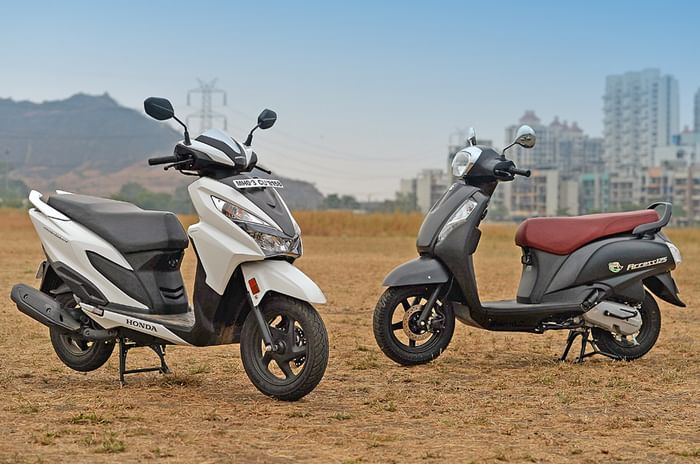

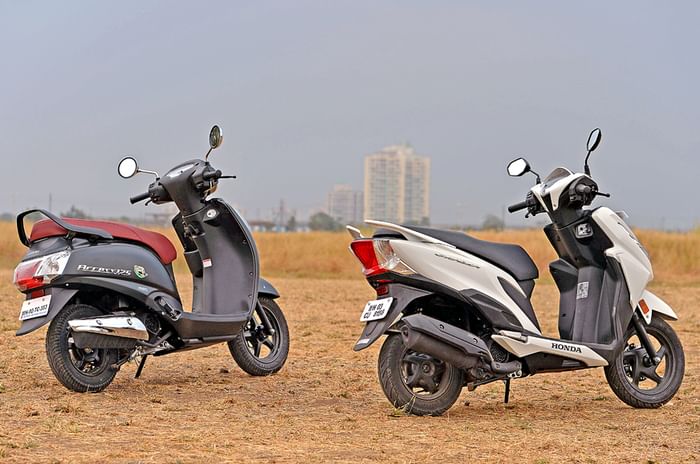
The premium scooter segment is on a steady incline and the 125cc point is its sweet spot. The 150cc scooters currently on offer are relatively pricey, not as fuel-efficient and therefore not as popular in our market, just yet. As such, the 125s of today have a lot of expectations riding on their shoulders. So far, the Suzuki Access 125 has proven itself as the best of the lot for its honest-to-goodness packaging of refinement, comfort, reliability and performance. Honda, however, is not one to let a potential market space go unaddressed and is taking a second hit at the 125cc space (after the Activa 125), with the Grazia.
WHICH LOOKS BETTER?
For our comparison, Suzuki loaned us the Access 125 SE (Special Edition) which is a decent attempt to liven up the Access’ fairly conservative styling. The SE gets matte-finish paint (black, in this case; the other colours are grey and white) with a contrasting red seat. It retains the chrome-bezel that sits neatly around its retro-cool trapezoidal headlight (which is a likeable and funky design) and now also features round, chrome mirrors – as opposed to the conventional black plastic ones on the regular Access. Black alloys are standard only with the matte black model while the others in the range get the same wheels painted silver. Overall, the Access looks conventional; not dramatic in any way but not offensive either. Its latest attempt to look trendy is nice, although Suzuki will need much more (a fresh and funky Swish, to be precise) to really outdo the competition on grounds of style.
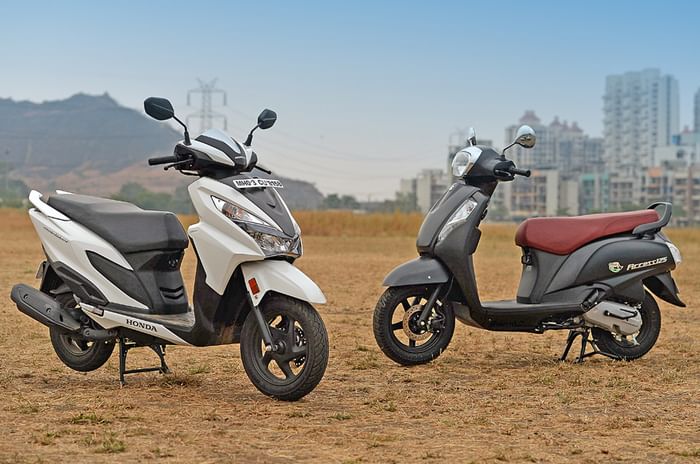
The Grazia definitely begs for bright, bold colours because its design is contemporary and reasonably aggressive. Most scooter enthusiasts I ran into during this test thought (in a nice way) that the scooter was a facelifted Dio and were vocal in their appreciation of it. That being said, the lack of a 125 badge anywhere on the Grazia is a missed opportunity, since it isn’t visibly larger than the usual fare of 110cc scooters. The LED headlight (a first amongst scooters) is styled well and the sharp lines all around the scooter give away its sporty intentions, in an instant. It’s neither as timeless as the Vespa nor as explicitly aggressive as the SR150, however. This means it will blend into the hordes of scooters, a few months from now – unless Honda decides to give it a bright yellow, like it did with the Dio. Staying away from design extremes works in the Grazia’s favour, however, since neither an 18-year old, nor a senior citizen will feel out of place on it.
WHICH ONE OFFERS MORE FEATURES?
The Grazia is clearly the more feature-heavy scooter as compared to the Access 125 SE. Its equipment list includes the aforementioned LED headlight, a disc on the top (Deluxe) variant, a fully-digital instrument cluster (with a tachometer and a 3-step eco speed indicator), a storage compartment with a hinged, fold-down lid, a 12V charging socket (optional accessory, about Rs 500 at the dealership), tubeless tyres and, of course, Honda’s proven Combi-Brake System (CBS). In comparison, the Access sticks to the basics, with a disc brake, alloy wheels, an analogue instrument cluster (with a digital fuel gauge), a cubbyhole in the apron and a 12V charging socket (optional, about Rs 50 at the dealership). The Grazia is clearly the stronger of the two in the feature-fight (on paper, that is), but barring the LED headlight, doesn’t offer anything that shines brightly (pun intended) over the Access’ real-world performance. That said, the LED headlight is definitely a welcome feature on a scooter and it does offer strong lighting performance in both low and high beams - a positive departure from the usual fare of scooter or even entry-level motorcycle headlights.
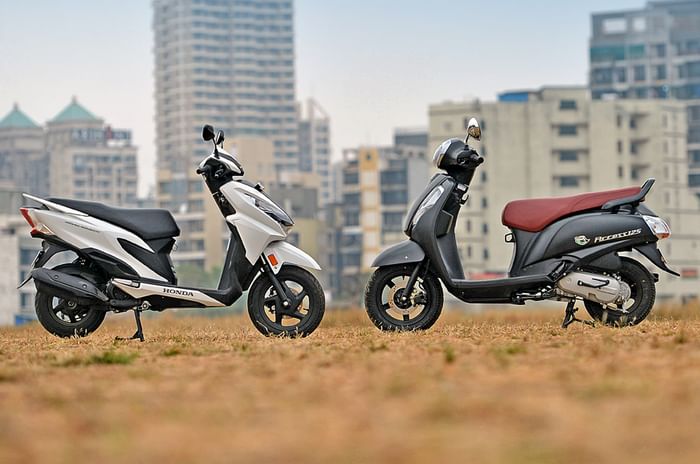
WHICH ONE HAS THE BETTER ERGONOMICS?
Here is where the Suzuki scores over the Honda. The Access, being devoid of sporty aspirations, to a large extent, is clearly more comfortable than the Grazia. Its riding geometry is slightly more sit-up-and-beg as compared to the wannabe-motorcycle upper-body stance the Grazia seats you in. This is something one will appreciate, especially over longer hours of commuting. Although the Access has a 780mm seat height as opposed to 766mm on the Grazia, it feels more relaxed and natural to be seated on. The Access’ comfortable seat is one of its highlights and it’s the one I’d choose over the Grazia’s Dio-sourced seat – which, by design, is inconvenient for taller riders.
I also found that the Access’ handlebar mostly steered clear of my knees in full-lock, low-speed turns while on the Grazia I needed to move my knees out of the way to avoid contacting the handlebar, at full-lock. Switchgear is almost identical on both scooters and the quality on both is good. The Access does feature a nice one-touch push-button electric start unit as compared to the Grazia’s conventional hold-until-it-cranks affair. However, the Access' stylish new round mirrors do compromise rearward visibility, which is better on the Grazia. The Grazia loses points for its crude brake lock lever which doesn’t belong on a premium scooter and is unusable in its current form. In terms of ergonomics, space and comfort, then, the Access 125 SE clearly dominates the Grazia.
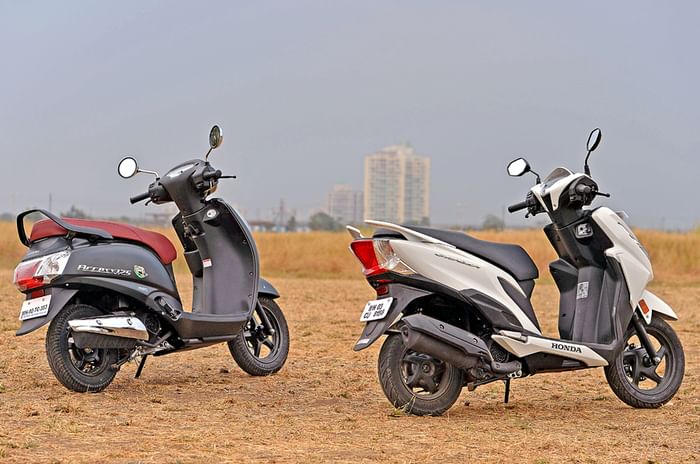
WHICH IS FASTER?
The Access’ 124cc engine produces 8.6hp at 6,500 rpm and is popular for both, its performance and refinement. It would be fair to call the Access’ motor the benchmark in its segment; but the Grazia, with its 124.9cc engine, is close on its heels. The Grazia’s motor produces 8.5hp at 6,500 rpm, 0.1hp less than the Access 125, and 10.54 Nm of torque at 5,000 rpm, 0.34Nm more than the Suzuki. What do these figures mean in the real world, though?
At low speeds, the Grazia feels more clinical and lacking character but it surpasses the Access towards its top end. Tested back to back, we found that the Grazia is the quicker of the two; it goes from 0 to 60 kph in 9.2 seconds (9.5s for the Access), from 30 to 60 kph in 3.7 seconds (3.9s for the Access) and from 50 to 70 kph in 7.4 seconds, which the Access does in 7.5s. You won’t notice this marginal difference while riding in isolation – although an impromptu traffic light drag race will conclude in favour of the Grazia.
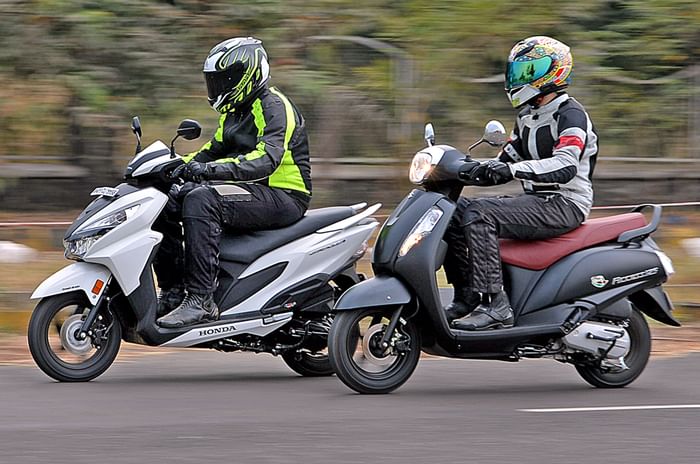
What’s visibly different between these scooters is the engine feel. The Grazia’s motor feels spirited and sounds slightly racy past 70 kph while the Access’ motor is punchy but always feels relaxed. The new Access has gotten milder as compared to the first-generation model and this change has its roots in Suzuki's customer base asking for it. Not everyone likes aggression in their scooters! I suppose college-going kids (with generous parents) will find the Grazia more fun. Its visual and ergonomic package definitely contribute to this.
WHICH ONE HANDLES BETTER?
Both the Grazia and Access make decent efforts to offer a stable, plush and fun riding experience. The cycle parts on both are identical; a telescopic fork is standard on either, so is the 12-inch front wheel and 10-inch rear (both run tubeless tyres), and both also feature a disc brake in their top variants. The Grazia does score over the Access with its Combi-Brake System, though. The Access, at 102 kg (kerb) is 5 kg lighter than the 107 kg Grazia although the latter does a good job of camouflaging its weight; neither scooter feels heavier than your average 110cc scooter.
Over potholes and consistently bad patches of tarmac, it’s the Access that absorbs better. The Grazia feels taut in comparison but not unreasonably so. It’s the Grazia’s sporty ergonomics that result in more undulations being filtered through to the rider although this turns to an advantage when it comes to handling. The Grazia’s front-end is more encouraging of aggressive cornering and it imparts with good, confident feedback. I found it most fun to throw into corners or quickly dart through traffic, but preferred the Access when I wanted to ride in a more scooter-appropriate (read: calm and relaxed) manner. The Access’ front-end feels relatively more scooter-ish than the Grazia – with a light feel but thankfully not to the point of being problematic.
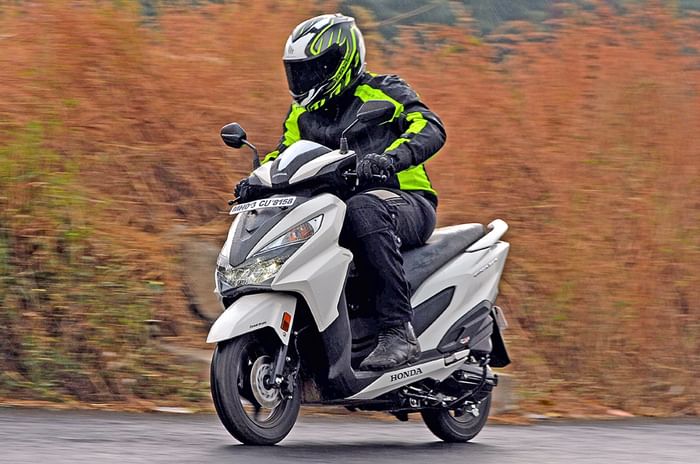
Braking is where the Grazia is clearly superior to the Access. In isolation, the Access comes across as stable and confident and the front disc brake certainly helps. It takes 2.2 seconds to come to a standstill from 60 kph, covering 19.3m in the process, which is appreciable for a scooter. The brake levers are progressive and, save for tyre squeal and rear wheel lock (towards the end of a hard braking manoeuvre) the Access, impressively, doesn’t lose composure. The Grazia, however, is better. Its brakes lack the progression of the Access but this is compensated for by the CBS, which is less demanding of the rider’s braking skill-set. Its MRF Zapper FG tyres are certainly better than the Ceat tyres on the Access and it shows – not only in the cornering poise but also in the brake-test results. The Grazia gets from 60 kph to standstill in just 2 seconds, covering only 18 metres in the process. This may seem like a negligible fraction on paper but its contribution to safety is crucial. This round clearly goes to the Grazia, then.
WHICH IS MORE FUEL EFFICIENT?
Both scooters have similar fuel tank capacities – 5.3 litres on the Grazia and 5.6 litres on the Access. On the highway, the Grazia returns a fuel efficiency figure of 57.6km per litre while the Access travels 54.5km on a litre. This is a marginal difference but an important one for those who want a 125cc scooter without compromising on fuel economy. The Grazia, therefore, has a highway range of 305 km, which is the same (down to the last decimal) as the Access which has the slightly bigger fuel tank. Shows exactly how competitive Suzuki and Honda really are, doesn’t it?
In the city, where it really matters, it's the Access that has the economical edge over the Grazia. While the Grazia returns a respectable 50.6 kpl in the city, the Access returns 52.6 kpl - a noticeable difference for the efficiency-minded.
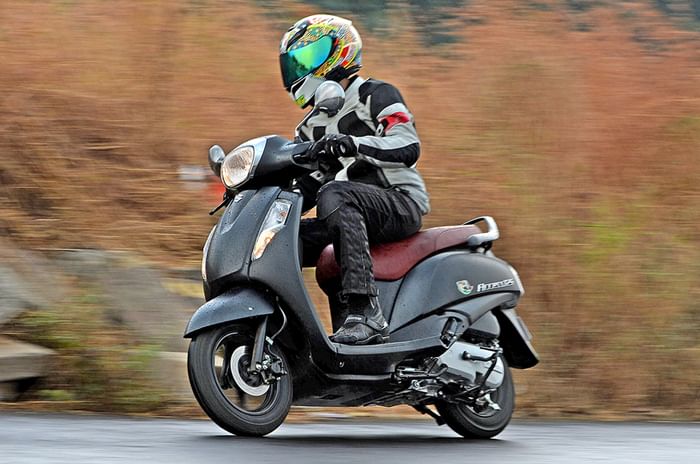
WHICH IS THE SCOOTER TO BUY?
Overall, there’s a lot to like about both scooters. While the Access is smooth, well-built, practical and agile, the scooter's styling and comfort-oriented dynamics direct its appeal towards an older (dare I say, wiser?) audience. If all you really want is a comfortable, stress-free urban runabout, you’ll be happy astride the cheaper scooter of the two, the Access 125 SE, which is priced at Rs 60,999. The Access, by being simple and straightforward, is the more intelligent scooter of the two and its robustness and no-nonsense appeal will definitely appeal to a wide audience in India.
The Grazia, however, has all the virtues of the Access but with the added bonus of an appealing design, involving dynamics and a few features (like the LED headlight) which riders will genuinely appreciate. It goes beyond just turning more heads and also offers marginally more involving performance/dynamics, better safety and more premium features. Priced at Rs 63,888 (all prices ex-showroom, Mumbai) the Grazia is slightly more expensive – but it is the better buy.
Copyright (c) Autocar India. All rights reserved.



Comments
Member Login
Personal Details
No comments yet. Be the first to comment.